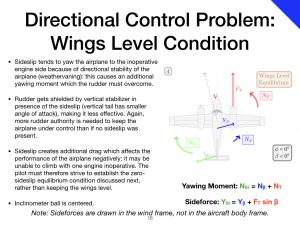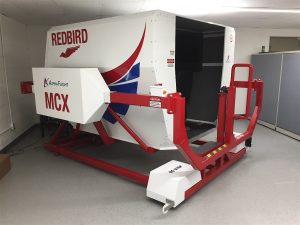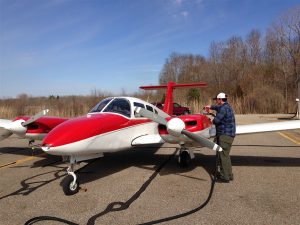Commercial Multi Engine Add On
A Private Pilot Version also exists for a PPL Multi Engine Rating
6-Day Regular Version: $5900
Definition of Commercial Multi Engine Add On
Commercial Multi Engine Add On Course: The commercial multi engine add on course adds a multi engine rating to a commercial pilot certificate. It thereby enables the commercial pilot to act as pilot in command of a multi engine airplane. An existing commercial pilot certificate with a different airplane class rating is a prerequisite for this commercial multi add on course.
A pilot who does not possess a commercial pilot certificate with an airplane rating yet should instead attend the Initial Commercial Multi Engine Course.
Comparison between 4-Day Accelerated and 6-Day Regular Version
This page describes primarily the 6-day regular version of this commercial multi engine add on course. To access the description of the 4-day accelerated version of this multi engine course, visit our accelerated training page (follow this link), it contains a detailed description.
However, it may be still useful for you to read the rest of this page nonetheless to compare the two versions of multi engine commercial add on courses and make an informed decision.
The two versions of the commercial multi engine add on are essentially the same, except that in the 6-day regular version you get two additional flight training days, and one extra hour of multi engine flight time. The price difference covers your multi engine instructor for the two additional days, as well as the additional hour of multi engine airplane rental.
The idea is that for the regular version of the commercial multi add on course – unlike the accelerated multi engine add on – you do not need to come exquisitely prepared. The two extra days in the regular version of the commercial multi add on are there for detailed ground instruction and potentially needed additional flying practice. We would still like you to familiarize yourself with the training materials beforehand and you should be proficient at flying in general, but during the multi engine commercial add on course, we will teach you everything about commercial multi engine flying that is new.
The larger price tag of this 6-day commercial multi add on course, compared to our accelerated version of the multi commercial add on, takes into account the two extra days of instruction. We recommend you take the accelerated version of the multi engine commercial add on, if you are self motivated and prepare beforehand. It will require less time to get your multi engine rating that way and will therefore reduce your multi engine add-on cost. Multi engine rating requirements Part 61 do not require a minimum amount of flight time, because you are adding and aircraft class. If commercial multi engine cost do not matter to you, the 6-day version is more relaxed.
In either version of this multi engine course, you will be flying with your multi engine instructor at all times and will therefore not need a multi engine solo endorsement (or more accurately, PIC endorsement).
Ultimately, it depends on you if you prefer to take the accelerated or this regular version of the commercial multi add on – whether you want to prepare yourself for the multi engine commercial add on course or if you would prefer us to prepare you.
Training Times Included
- Course Duration:
5 days of commercial multi engine add on training, plus one day for FAA Practical Test (usually with an extra day as weather backup for the test if the examiner’s schedule allows). - Flight Training:
8 hours of multi engine flight instruction in a Piper PA-34-200 Seneca. - FAA Practical Test:
Up to two hours of multi engine airplane rental for the commercial multi engine add on checkride are included in the course price. (If you do not hold an instrument rating, you will be multi engine VFR only.)
The examiner fee of $700 is not included and payable directly to the examiner on the day of the practical test. - Ground Instruction:
8 hours of instruction by your multi engine instructor (review of multi engine theory, oral exam preparation) is included on the above 5 training days. Whatever time is not used for flight is used for ground instruction.
Multi Engine Course Cost
Course Cost: $5900
Includes everything listed on the left. This course estimate is predicated on the assumption that the candidate finishes within the times listed.Additional Flight Training Time:
If additional flight training is needed beyond the hours listed on the left, the price is $350/hour for the Piper PA-34-200 Seneca and $60/hour for flight instruction.- Additional Ground Instruction:
Any additional ground instruction needed costs $60/hour.
Frequently Asked Questions
How to Earn a Commercial Multi Engine Rating?
There are several ways to earn a commercial multi engine rating. The most common way is to take a commercial multi engine add on course like this one. It assumes you already have a commercial pilot certificate with another airplane rating, and are adding a multi engine rating to your existing pilot certificate level.
The second way is to do an initial commercial multi engine course. This applies if you either do not hold a commercial pilot certificate yet or you have one with a rating in a different aircraft category (not aircraft class). This approach will allow you to avoid having to take take airplane single engine land commercial checkride (with checkride maneuvers like lazy eights and chandelles), and you will get more multi engine flight time that way, which is more valuable if you want to go to the airlines. The downside, however, is that if you want to become a flight instructor (CFI), you will be restricted to teaching in multi engine airplanes, until you take your single engine commercial checkride and the single engine airplane flight instructor checkride. If you know of a multi engine flight school that will hire you, this may not be a problem. But keep in mind that there are far more single engine CFI job opportunities, especially for new, inexperienced flight instructors. Not being able to teach in single engine airplanes is rather restrictive for a CFI.
At Academic Flight we offer both commercial multi engine rating courses and – without our own personal preference – we would like you to choose whatever is best for you.
How much does a Commercial Multi Engine Add On cost?
The cost of a commercial multi add on can vary dramatically depending on with which flight school your are taking the multi engine course. They range from $3000 to $6000, though some flight schools may deliver it for as low as $2500, and a few are more expensive than the aforementioned range.
The driving factors for commercial multi add on cost include:
- Accelerated vs Regular Multi Engine Course: Are you taking an accelerated multi engine commercial add on? If so, it will probably be cheaper, because of less flight time and less ground instruction as well. Everything during your commercial multi course will be compressed into a few intense days. Everyone will be very focused, your multi engine instructor will know you have limited time. In contrast, the regular commercial multi engine add on course, especially if taken at a flight school not specializing in multi engine training, will likely drag out if you fly once or twice a week. More flight time and preflight briefing time will rack up the bill, without really adding much value. You would be amazed how much a focused multi engine add on student and instructor team can achieve in just a few days during accelerated multi engine training. (This is not to say though that some multi engine flight schools just teach for the commercial multi engine add on checkride – this practice your be avoided.
- Presence of a Flight Simulator or AATD: Having a multi engine flight simulator available like the Redbird MCX AATD is a huge asset for the multi engine course. A typical accelerated commercial multi engine add on takes 7 hours of flight time. Some flight schools claim that with the help of a flight simulator they can get the multi engine training time down to 5 hours, but that is really short, as you will probably have time to go through all the multi engine add on maneuvers three times. Saving 2 hours also does not reduce the multi engine add on cost dramatically.
Where we see immense value in the multi engine flight simulator is that it will ensure finishing in 7 hours without needing more multi engine flight time and thus not having to pay extra. This makes the commercial multi engine add on more affordable for many, as many multi engine add on students who arrive underprepared go over time if they are not focused razor-sharply. With the flight simulator, no matter how unprepared the multi engine student arrives or how inept the student is, the multi engine instructor can simply wait with putting the student in the multi engine airplane, until the student is truly ready. - Location of Flight School: The multi engine training Florida has to offer, for instance, tends you be less expensive than, say, urban areas in central California. Arizona and Georgia are also known for somewhat lower prices. However, finding the cheapest commercial multi engine add on school is not really the point, and the travel and housing cost associated with a trip there oftentimes negate any of the cost savings, especially if weather delays the commercial multi engine add on course.
References
Upon registration for your multi engine commercial add on course, you will receive an email with our own proprietary electronic training material package. It would be very beneficial to familiarize yourself with it before arriving for your commercial multi add on course. Below we provide a few links to relevant multi engine references published by the FAA and by test pilot schools (the latter are optional, though we will gladly discuss them with you, especially since this is the longer version of the commercial add on).
FAA Publications
- “Airplane Flying Handbook,” FAA-H-8083-3B, U.S. Department of Transportation, Federal Aviation Administration, Flight Standards Service, Washington D.C., 2016, (Chapter 12: “Transition to Multiengine Airplanes”).
https://www.faa.gov/regulations_policies/handbooks_manuals/aviation/airplane_handbook/ - “Pilot’s Handbook of Aeronautical Knowledge,” FAA-H-8083-25B, U.S. Department of Transportation, Federal Aviation Administration, Flight Standards Service, Washington D.C., 2016.
https://www.faa.gov/regulations_policies/handbooks_manuals/aviation/phak/ - “Airman Certification Standards,” U.S. Department of Transportation, Federal Aviation Administration (FAA), Washington D.C.
https://www.faa.gov/training_testing/testing/acs/
Test Pilot School Textbooks
- USAF Test Pilot School, “Flying Qualities Textbook,” Volume II, Part 2, USAF-TPS-CUR-86-03, Edwards AFB, California, April 1986, (Chapter 11: “Engine-Out Theory and Flight Testing”).
http://www.dtic.mil/dtic/tr/fulltext/u2/a170960.pdf - “U.S. Naval Test Pilot School Flight Test Manual: Fixed Wing Stability and Control –Theory and Flight Test Technique,” USNTPS-FTM-No. 103, Naval Air Warfare Center, Aircraft Division, Patuxent River, Maryland, January 1997.
http://www.usntpsalumni.com/Resources/Documents/USNTPS_FTM_103.pdf



